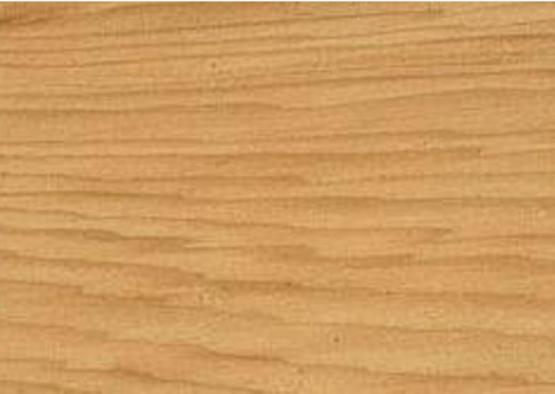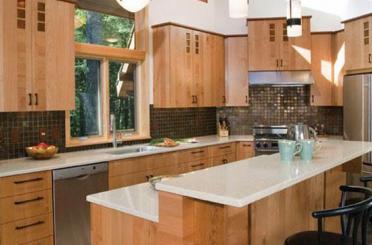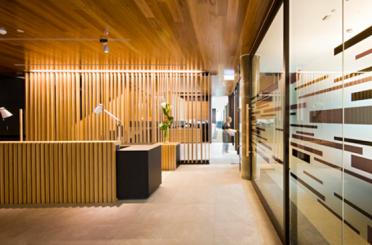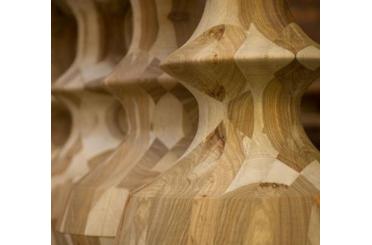Celery top pine is an attractive, durable and easily worked softwood, pale when cut and then darker with age, used in boat building, joinery and turnery, and interiors.
Tasmanian Celery Top, Phyllocladus rhomboidalis
Phyllocladus asplenifolius

Celery top pine is a strong, durable and attractive softwood that grows in Tasmania, and is available there and in Victoria. It is a rare wood and available only from specialist timber retailers.
The heartwood of celery top pine is pale yellow to pale brown, which darkens to gold as the heartwood ages. The sapwood is narrow and not readily distinguishable. The texture is fine and even and the grain is usually straight, and the growth rings are conspicuous and very close together. In timber from smaller trees there are a large number of knots. The heartwood is durable below and above ground, though it is susceptible to the lyctid borer and is not termite resistant.
The strength, durability and ease of working of celery top pine have made it popular in the making of vats (specially for acid storage), garden furniture, joinery, kitchen utensils, turnery, carving, and in boat building.
Shrinkage
| Very Low | Low | Medium | High | Very High | |
|---|---|---|---|---|---|

|

|
||||
Tangential : |
3.10%
|
||||
Radial : |
1.60%
|
||||
Unit Movement Tangential: |
0.19%
|
||||
Unit Movement Radial: |
0.11%
|
Strength Group

Very High |
High |
Reasonably High |
Medium High |
Medium |
Reasonably Low |
Low |
Very Low |
||
Unseasoned: |
S1 |
S2 |
S3 |
S4 |
S5 |
S6 |
S7 |
S8 |
|
|---|---|---|---|---|---|---|---|---|---|
 |
|||||||||
Seasoned: |
SD1 |
SD2 |
SD3 |
SD4 |
SD5 |
SD6 |
SD7 |
SD8 |
|
 |
Stress Grade

| Structural No. 1 |
Structural No. 2 |
Structural No. 3 |
Structural No. 4 |
Structural No. 5 |
|
Unseasoned: |
F14 |
F11 |
F8 |
F7 |
F5 |
Seasoned: |
F17 |
F14 |
F11 |
F8 |
F7 |
Density per Standard

Seasoned: |
645kg/m3
|
|---|---|
Unseasoned: |
1050kg/m3
|
Joint Group

Very High |
High |
Reasonably High |
Medium |
Low |
Very Low |
|
Unseasoned: |
J1 |
J2 |
J3 |
J4 |
J5 |
J6 |
|---|---|---|---|---|---|---|
 |
||||||
Seasoned: |
JD1 |
JD2 |
JD3 |
JD4 |
JD5 |
JD6 |
 |
Colour

| White, yellow, pale straw to light brown | Pink to pink brown | Light to dark red | Brown, chocolate, mottled or streaky | |
 |
||||
Mechanical Properties
Modulus of Rupture - Unseasoned: |
69
|
|---|---|
Modulus of Rupture - Seasoned: |
98
|
Modulus of Elasticity - Unseasoned: |
9.4
|
Modulus of Elasticity - Seasoned: |
12
|
Maximum Crushing Strength - Unseasoned:  |
36
|
Maximum Crushing Strength - Seasoned: |
56
|
Impact - Unseasoned: |
7.6
|
Impact - Seasoned: |
6.5
|
Toughness - Unseasoned: |
|
Toughness - Seasoned: |
|
Hardness - Unseasoned: |
3.9
|
Hardness - Seasoned: |
4.5
|
Durability
| Low | Moderate | Reasonably High | High | |
| (0 - 5 yrs) | (5 - 15 yrs) | (15 - 25 yrs) | (more than 25 yrs) | |
In-Ground: |
 |
|||
| (0 - 7 yrs) | (7 - 15 yrs) | (15 - 40 yrs) | (More than 40 yrs) | |
Above ground: |
 |
|||
| (0 - 20 yrs, usually < 5) | (21 - 40 yrs) | (41 - 64 yrs) | (More than 60 yrs) | |
Marine Borer Resistance: |
Lyctid Borer Susceptibility: |
Not Susceptible |
|---|---|
Lyctid Borer Susceptibility - Other: |
|
Termite Resistance: |
Resistant
|
Fire Properties
Critical Radiance Flux - Lower: |
>2.2 and <4.5 |
|---|---|
Critical Radiance Flux - Higher: |
>2.2 and <4.5 |
Smoke Development Rate: |
<750
|
| 1 - non-combustible | 2 - reasonably non-combustible | 3 - slightly combustible | 4 - combustible | |
Fire Properties Group |
Group Number - Other: |
3 if used on MDF or particleboard ≥12mm; veneer thickness 0.6-0.85mm
|
|---|---|
Average Specific Extinction Area: |
<250
|
Bushfire Resistance: |
Not Tested
|
Celery top pine’s sapwood is narrow and not readily distinguishable. The heartwood is pale yellow to pale brown, which darkens to gold as the heartwood ages. In timber from smaller trees there is a large number of knots. The texture is fine and even and the grain is usually straight, and the growth rings are conspicuous and very close together.
Celery top pine’s strength, durability and ease of working have historically made it popular for boat building, cladding and paneling benchtops, flooring, decking, joinery, furniture, beams and poles. It is also used for vats, with its toughness making it useful for the storage of acids.
Celery top pine is easily worked. It drills cleanly to size, bends and turns well planes well with the grain, and accepts varnishes, paints and stains without difficulty. It may need predrilling as it can be hard to nail when seasoned.

Joinery

Panelling, Interior

Mouldings
Allied Forest Products
Britton Timbers

HYDROWOOD

Matilda Veneer

Ridgewood Timber Pty Ltd


